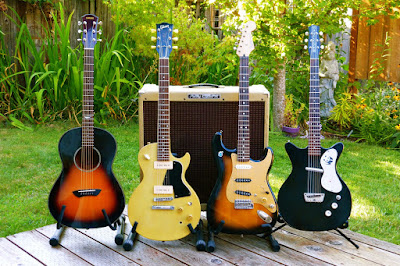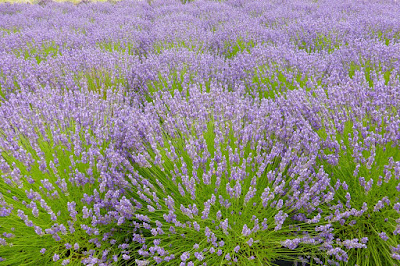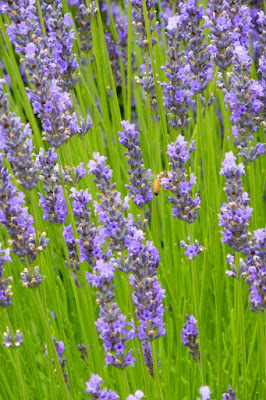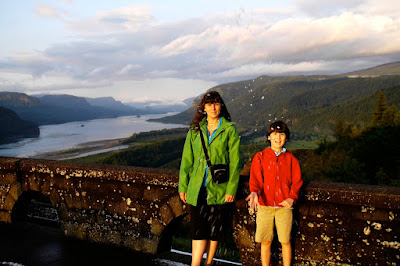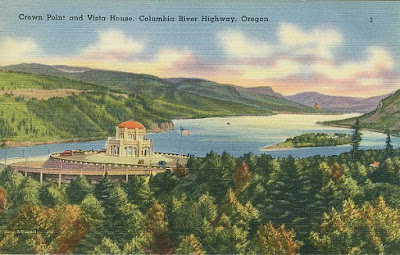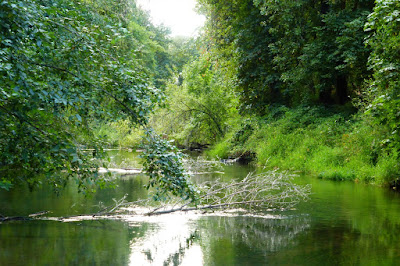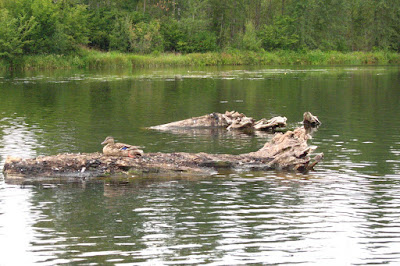A couple of days ago I joined a rock and roll band. It wasn't something I was looking to do; it just happened.
Wanna Join a Band?
Last month I answered a craigslist posting for a Danelectro Daddy O. overdrive pedal, and while testing it at the seller's house I ripped a couple licks to see how the pedal did into his tube amp, it sounded great, bought it and went home. A couple weeks later the seller called and said he was putting together a band with a few good players, and did I want to play "lead" guitar? Well... why not. I went to a rehearsal + mutual audition, and hey, these guys are good, and every one of them seem like decent folks.
The basic sub-genre is what's known as classic rock, and it's mostly top 40 songs from decades ago that a lot of people of a certain age group and demographic consider the soundtrack of their lives, or something. As some of my ethnically diverse friends call it, "white boy music". Somehow, I managed to live through that time period without listening to much hit radio, so a lot of this is new to me. Seriously, until last week I had no idea what Boston, Bon Jovi, or Blue Oyster Cult sounded like. And that's just the "B"s.
Anyway, I get to play really loud along with a slamming rhythm section, do simple shifting chordal stuff while singing harmony, and do my screaming solo guitar thing, which is easy to do with an amp turned way up. It's like Muhammad Ali said: "Float like a butterfly, sting like a bee". Okay, it's been a long time since I played any rock music, and I've never been in a covers band before, but I think I can do this.
Maybe I Need More Gear
Probably not. How much stuff do I need? I now have four guitars (see the picture at the top of this page), and for me, that's a lot. In addition to those guitars, I also have an old Danelectro bass, a good cheap and new Epiphone mandolin, and a blond 1950s Wurlitzer spinet piano in the living room that never goes anywhere. That covers a lot of tonal territory, and I'm not an obsessive collector. My guitar "arsenal" at this moment:
• The
'59 Danelectro is a real, made in New Jersey, 1959 Dano. A gift from my brother
Jonsan,
I never knew the model name, maybe it doesn't have one.
The important thing is, in spite of being a bargain basement
instrument of its day, it's one of the very finest
sounding, and playing, guitars I've ever had the pleasure of squeezing
notes out of. Lightweight, toneful and resonant, with a great feeling
neck and about the highest hi-fi pickup ever, it's my "desert island"
guitar - if I had to pick just one, this would be it. And its flattish
large radius fretboard makes the Dano an almost perfect slide guitar,
too.
• The Yamaha CSF-60 parlour sized acoustic is the only mail order guitar
I've ever bought. Actually, it's an online purchase, from a small shop
in Burlington, VT. I'd read a glowing review of the CSF in the Guitar Player mag
in the early 2000s, and was always looking to meet one in person, but
never did. Then they were discontinued, and so - oh well too bad, missed
out. In 2008 I saw one for sale, NOS, a slightly shop worn
demo, but who cares - sold on the spot, and thanks Google. One great
thing about buying from a "real", smaller shop is that they usually take
the time to set up their guitars well, as this one was.
When the Yamaha six string mail order bride arrived, it didn't disappoint: a really nicely made and very playable acoustic. Maybe a
bit stiff feeling, with a smallish voice at first, but a couple months
of daily playing this all solid wood guitar really opened up it up tonally, as I knew
it would. As the GP article said, it sounds much larger than it actually
is (it's about the same size as a typical electric!), and strung with
John Pearse nickle wound 12-53, it's even more so. Pop in a Markley
magnetic soundhole pickup, and through a good tube amp the CSF-60 can
go all the way from Django-esque Maccaferri sounds, to clear voiced bluesy and folk style fingerpicked tones, to full bodied yet jangly
strumming with a thin-gauge pick, to fat jazzy
single note lines and chord solo comping. Versatile indeed.
• My old Gibson Les Paul Model 55-77 TV Special in a limed blond finish, is a fantastic player and always has been ever since I bought it new, and sounds every bit as good as it looks. One piece flat top mahogany body with no maple cap; a strong three piece bound mahogany neck with a smoothly tapered profile that ranges from slim near the nut to chunky at the heel, and a rosewood fingerboard with big fat frets; a pair of the classic early '50s design wide and harmonically rich single-coil Gibson pickups, now known as P-90. It's all original, except for modding the wiring to suit myself, and the tuners have been replaced a few times; they had a habit of breaking when I was a young stupid rocker running around and sometimes jumping off stages. Amazing that it, and I, are still in one piece.
• The recently put together and still ongoing
Fender JapaMexiCaster (MIJ body, MIM neck, various parts) project guitar is turning out well, I got lucky with the assembly. Good, usable tones right off the bat, no adjustments needed,
and the neck is a dream to play. I like to do a lot of bends and string
vibrato, and friend David's sterling fret work makes playing almost effortless. The Squier Classic Vibe flat top
pickups, with vintage spec lower output, simply sound great. Without staggered pole piece magnets, all the strings have uniform output, throughout the entire fretboard. Also, the pickups mounted on a metal pickguard (anodized aluminum) instead of plastic gives a very Tele like tone. This guitar isn't quite done yet, but good enough to play right now.
 |
| A Nice Pair: Classic 50 And Franken-Caster |
Buddy Can You Spare an Amp?
Compared to me, the guys in the band have tons of nice equipment; Donnie the drummer has a fully equipped recording studio out in the country where we practice, and John the singer has at least a dozen guitars and 3 or 4 amps. I have some low wattage home-brew amps but nothing really gig-able, so John has kindly and graciously let me use a Peavey Classic 50 4X10 for the time being, until I can cobble up my own rig.
The Classic 50 is quite a decent amp, gets loud enough and has a nicely voiced clean channel, excellent for use with effects. Set the master full up, with the gain about 4 to 4 1/2, and it gets close to a 1960s silver-face style tone; coupled with the efficient and crisp sounding Eminence 4x10" speakers in an open back cab, it easily keeps up with a hard punching drummer. As with most modern amps, the overdrive channel isn't very natural sounding, but the clean side is where it really shines as an all around usable and capable jam and gig rig. Overall the C-50 sounds just short of great, and I've heard these amps are very rugged and dependable. Plus, it looks like cool '50s tweed style retro.
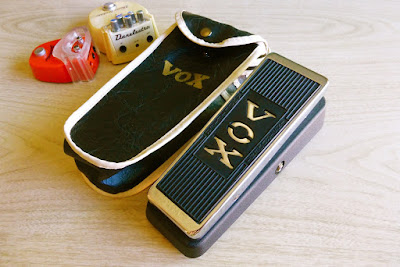 |
| Hey - Wahs In The Bag? |
I Don't Need No Wah Wah, But I Got One Anyway
It was time to open up the old effects pedal suitcase (and a couple cardboard boxes full too), dump them out onto the floor, dust the little suckers off, and get reacquainted with all of them, which was a lot of fun in itself. Made some shorty cables, plugged up a few likely suspects, and gradually narrowed the floor-toy field down. I have way too many effects units, from all eras and price points, and a few rose to the top of the stomp box heap based on their sound and how well they worked together.
 |
| Whoa - Daddy O. |
My pedal setup for now:
• Danelectro Daddy O. - The Daddy O. is first in chain, always on, gain about 1/3 up, with maybe 40-50% overall volume boost. Set up that way, it's not so much an effect, but rather a slightly overdriven basic tone generator and general buffer line-amp pedal, boosting the signal slightly to keep a wah and other pedals down the chain tone-happy. With gain, master volume, and bass, mid, and treble controls, there's a lot of useful tone shaping here; pedals set up like this have recently been called "amp in a box", and that's a fair description.
It's been said that the Daddy O. is a favorite of some famous name guitarists, and I can see (and hear) why. Like a good tube amp, this versatile pedal has a very wide dynamic range: with the guitar volume rolled back, the tone is fairly clean, with a lot of punch and fidelity. Turn the guitar volume pot up, and the sound gradually gets bigger and fuller, with that gritty edge reminiscent of an amp with hot glowing tubes, cranked way up.
• Ibanez UE 300 - After the Daddy O., it's into an early '80s
Ibanez UE 300 all analog three-in-one effects box, which has a compressor / limiter (only used as an effect, and not always on - useful for Lowell George-like slide parts) and a period correct TS-808 Tube Screamer section, before the signal goes to the built-in external loop send jack.
• Danelectro Chicken Salad - Then, it's out to a Danelectro Chicken Salad vibrato - a very good sounding real optical process Uni-Vibe clone, not a simulator or digital emulator. Really nails that smoky, swirling pitch-shift "Bridge of Sighs" vibrato sound.
• Ibanez DL-5 delay - Next is the lady-bug shaped early '90s Ibanez DL-5 Soundtank digital delay, with short to
medium delay times that sound totally analog, with none of the usual digital delay harshness or sterility. As a side note, Ibanez is an amazing company - even their lower end pedal lines, such as the plastic enclosure Soundtanks, don't sound at all like econo-boxes, with superior audio response and believable effects.
• Vox V-947 wah - After the delay, it's into a chrome top Vox V-847 wah-wah pedal. Not an old Thomas Organ company wah, but a '90s Jim Dunlop reissue. I used to have a Thomas Vox wah, and though this Dunlop has the same retro '60s vibe and look as the Thomas, it sounds somewhat different. It's more like a Cry Baby wah in a Vox skin, and that ain't bad. The important thing is that this Dunlop/Vox doesn't have full bypass switching or an active buffer in the circuit - it's set up just like all the original wah pedals from the 1960s and '70s were.
Many self-styled experts and online forum posters frown on wahs, or any other effects boxes, that don't have what they call "true bypass" switching, but consider this: think of any great classic recording from the 1950s through the '80s, with a wah guitar on it - you're hearing an un-bypassed wah pedal, whether Vox or Cry Baby or Jordan. Even if you never use it, having an old style wah in the effects chain does something to the overall tone of the guitar and amp, smooths it out, takes off some high end harshness, and adds an indefinable mojo or magic. It's rock and roll.
• After the wah, it's back into the loop return input of the Ibanez UE 300, and the analog stereo chorus in the UE pedal, which can sound very Leslie like. After the chorus, the signal goes through a JRC4558 IC output buffer in the multi-box, which powers it out the long cable to the amp.
Except for the delay which is rarely on, the effects chain is all analog, no modeling, no PCM, no emulation, no modern style tone-sucking multiple A/D and D/A converters - and played though a big tube amp, the tone is fat, complex, alive with rich harmonic overtones, and very 33 1/3 rpm.
 |
| Yumm - Chicken Salad |
 |
| UE Dewey And Louie |
But What's Rock and Roll Without Distortion?
I tried all the distortion and fuzz pedals I had (kind of embarrassed to say I own 17), and although each one had its own unique character and sound, none of them had that sort of raging British amp stack on the verge of blowing up sound that I had in my head. But then I tried this: turned the gain way up on the Tube Screamer in the UE 300, and rolled the tone way back, and voila. The combination of the Dano Daddy O. set on low overdrive running into the pushed Screamer adds up to a really nice wailing distortion, with tons of long singing sustain: pretty darn good enough with the Strato-Parts-O-Caster and '59 Danelectro, and incredibly thick and moaning with the P-90 neck pickup of the '77 Les Paul Special. Much of the credit for that big tone may be due to the Ibanez UE 300 being chock full of the famed early '80s JRC-4558 ICs, although - who knows? Maybe it's just more audio magic.
 |
| They Call It A Tank, But It Looks Like A Bug |
 |
| Well, Here's Another Nice Mess... |
 |
| Cute, But It Only Lasted Six Minutes In The Chicken Salad |
Dead Battery Blues
I went to get some 9 volt batteries for all the pedals, and whoa, they're really spendy - like $4 apiece for alkalines. So I bought a pedal power adapter, a One Spot, just like everyone else in the world. While a useful thing to have, a 9V adapter setup has downsides, including the added wiring mess - see the photo above. One solution would be a pre-wired pedal board. But an effects board would mean lugging another bulky thing around, instead of carrying the pedals in the old, nicely beat up, and funky tweed Towne suitcase, which has seen hundreds of stages and jam rooms in its (and our) past lives.
 |
| Ol' Tweed |
Eventually I'll need to find my own good and loud and gig worthy amplifier, and maybe I'll buy the Classic 50. And messing around with gear is great, but now I really need to get some serious practice and rehearsal time in.
I'll admit it - my playing style is weird: flat pick and two fingers, country chicken-pickin' meets the blues, with J. J.
and Keith and Willie and B. B. and Doc and Wes jamming bossa nova in
the club car of a lost train heading out to that mythical hula party in
the sky, musical mash up. It's gonna be fun warping that into something that fits into the "classic rock" speedy white boy music thing.
 |
| Sennheiser e 835 |
A final note: my band and jam vocal microphone of choice is a Sennheiser
e 835 - super intelligible, slices through even the densest mix, a top quality German mic for $99 - and it sits on an ancient 1960s Shure cast-base stand.
* * *
All photos taken with a Lumix ZS25. Click or tap on any picture to see larger, higher def images.







